Greek Cheese Saganaki (Σαγανάκι)
Learn how to make special Greek cheese saganaki at home with this authentic recipe. This popular Greek meze is no longer something you can only enjoy at a Greek restaurant – now you can make it yourself!
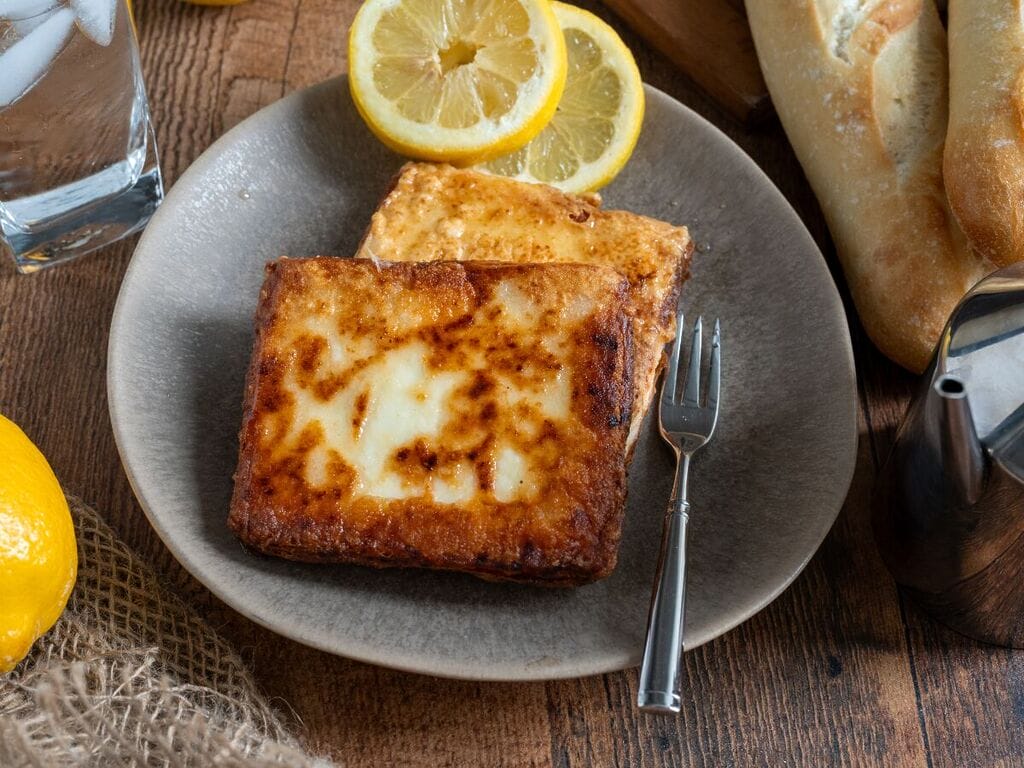
Growing up in a Greek home to immigrant parents who watched every penny, eating out was a rarity. I can count on one hand the number of times we would eat in a restaurant, unless we were on vacation. We weren’t missing out on anything though, because the food at home was as good at, if not better, than any restaurant food we could have. My parents mastered making Greek specialities like Moussaka, Dolmades and all the Best traditional Greek dips and spreads.
Making cheese saganaki at home was also something they did often, and when we would see that block of Greek cheese come out of the fridge, ready to be fried, we got really, really excited!
If you have never had cheese saganaki…I am so sorry. But, I am also really happy that you are reading this, because now, you’ll be able to make this easy, fantastic cheese appetizer for yourself, and anyone else you want to be really nice to.
Why I love this recipe
First of all, the Greek cheese used to make this authentic Greek meze is amazing. In my family we use either kefalotyri or kefalograviera, and both are amazing.
Ordering cheese saganaki in a Greek restaurant is usually expensive. You can make it at home even better for much less.
With my special technique, the outside of the cheese saganaki is crispy, while the cheese on the inside is soft, melty and sublime! Yes, sublime! That is not an over-exaggeration!
Key ingredients
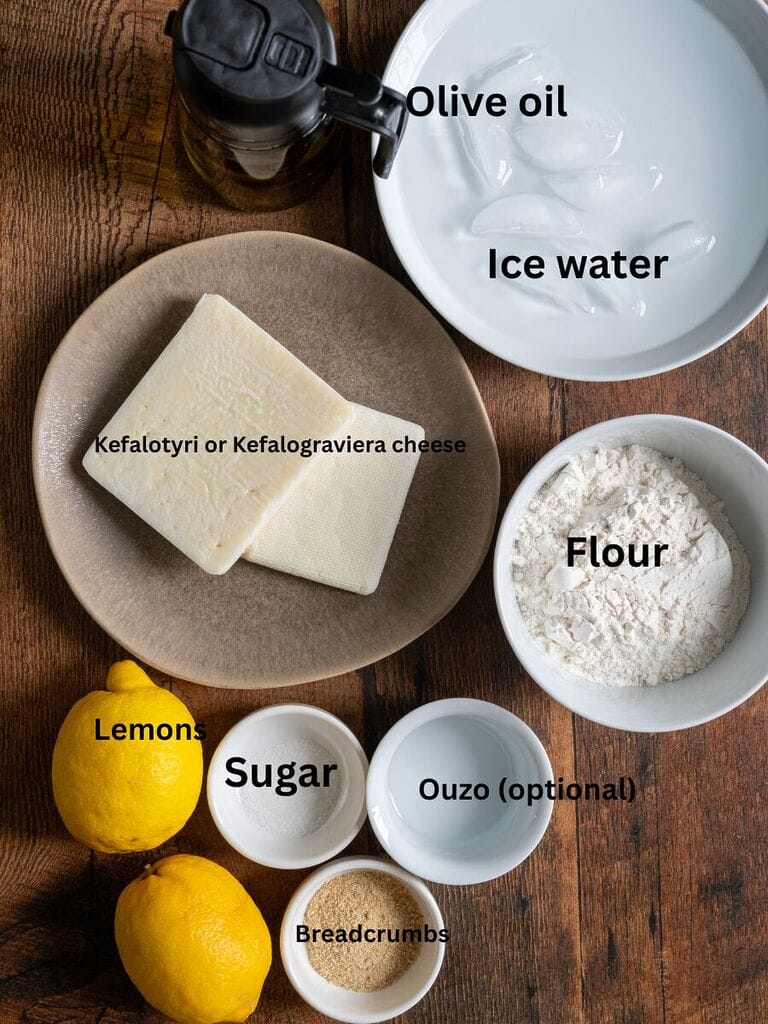
Kefalotyri or Kefalograviera These are both great options for saganaki. These Greek hard cheeses are made with sheep or goat milk and have a creamy, fruity and delicious flavour. The texture is perfect for frying! They hold their shape well, but still get soft and melty! So good!
Flour I use plain, all-purpose flour to make my cheese saganaki.
Bread crumbs I add some plain breadcrumbs to my cheese saganaki flour mixture because I like the texture it provides.
Sugar A bit of granulated sugar helps to caramelize the crust, and adds a slight sweetness.
Ice water A bowl of ice water is key to making the best cheese saganaki! It makes sure that the flour coating remains on the cheese, and does not burn in the pan.
Olive oil I fry my cheese saganaki in Greek olive oil. It tastes great and works really well in this recipe!
Lemon I love to serve my cheese saganaki with fresh lemon wedges! The citrus tang is so great!
How to make it
Step 1
Find two bowls whose dimensions are larger than the pieces of cheese. In one, mix together the flour, sugar and breadcrumbs. Fill the second bowl with ice water.
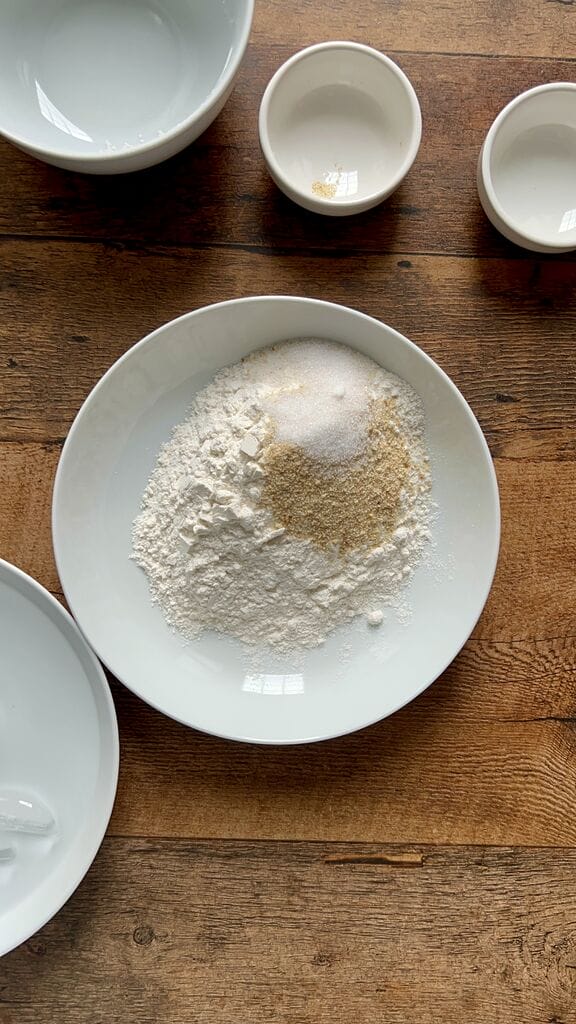
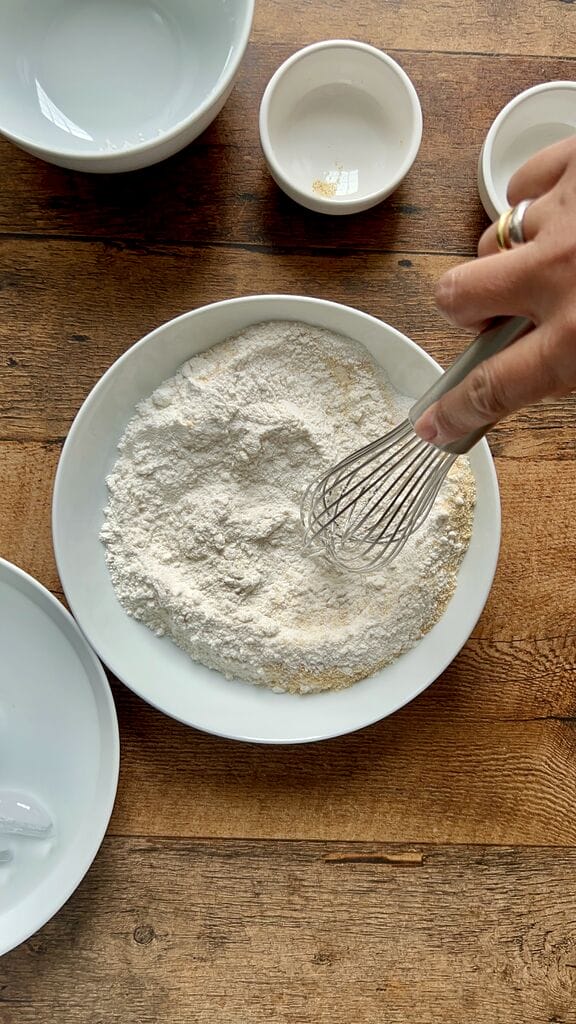
Step 2
Pour enough olive oil into a frying pan so that it covers the bottom of your pan and is about 1 cm deep. Heat over medium heat.
Step 3
Taking one piece of cheese at a time, dunk it into the ice water and then coat it with the flour mixture. Dunk back in water, then back in flour. Finally, dunk quickly in the water for the third and last time.
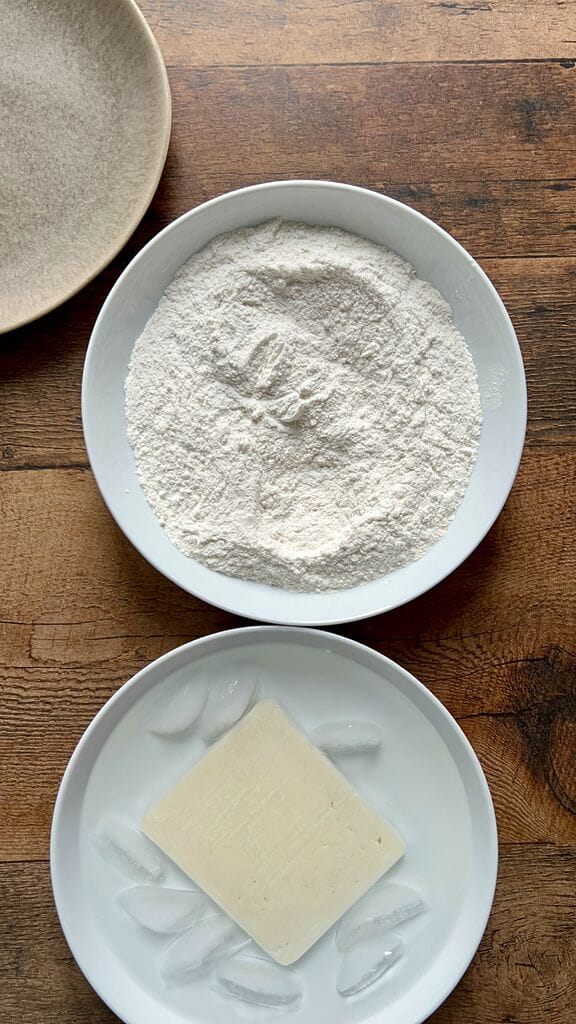

Step 4
Immediately place your cheese into the preheated frying pan.

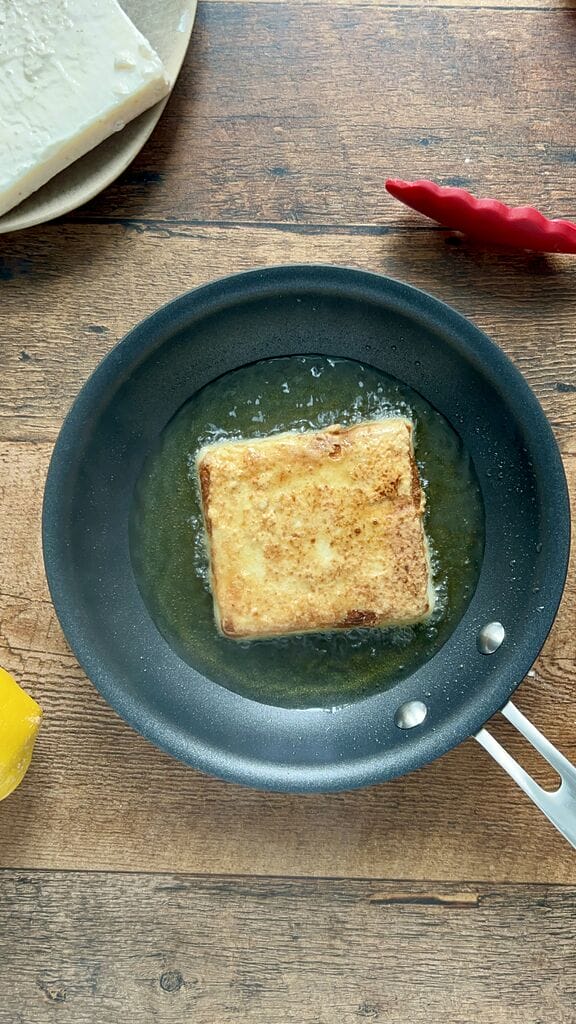
Step 5
Repeat with the other pieces of cheese, and fry as many as you can at the same time, without overcrowding the pan.
Step 6
Fry each side for about 3 – 4 minutes until golden brown. Flip over carefully and fry on the other side.
Step 7
Serve immediately with lemon wedges.
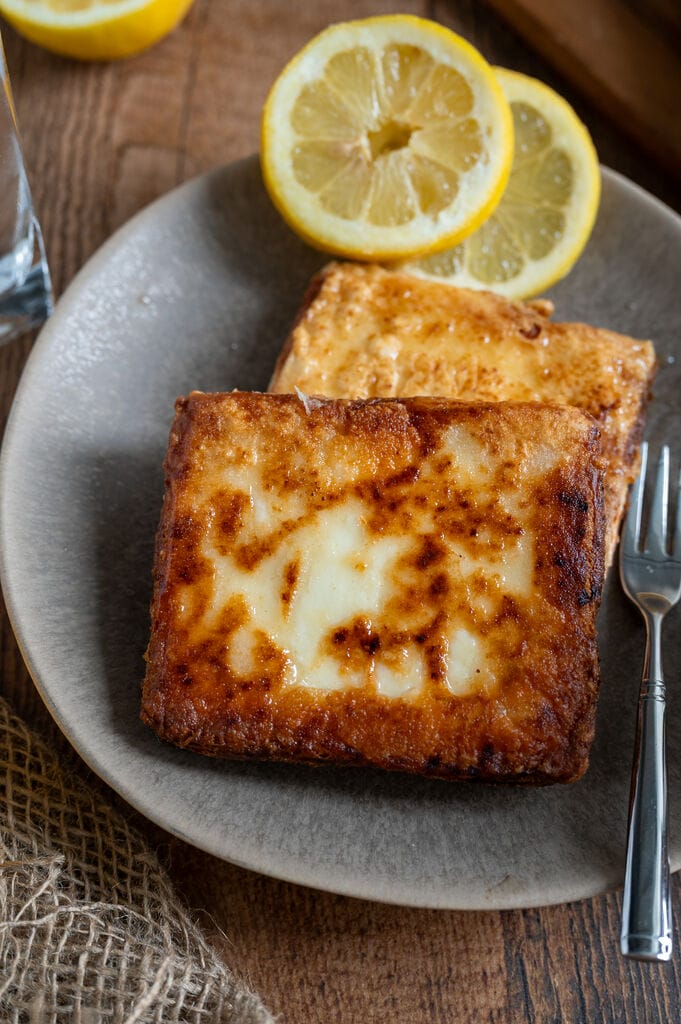
Recipe substitutions
You can make Greek cheese saganaki with another cheese, other than kefalotyri or kefalograviera. You can use halloumi, kasseri, and some people even use feta.
You can choose to fry your saganaki in vegetable oil if you prefer (although why would you?)
To keep this recipe gluten-free, use gluten-free flour and breadcrumbs. If you cannot find gluten-free breadcrumbs, simply omit them.
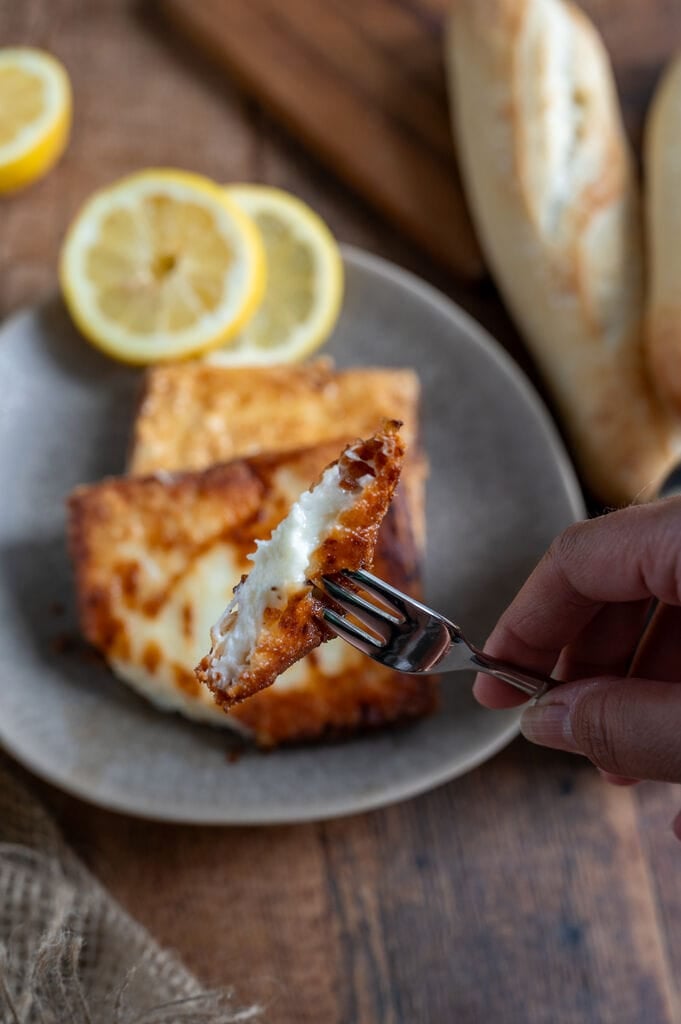
Helpful hints
My parents always add breadcrumbs to the flour mixture when they make cheese saganaki, as they find it give an extra bit of crunch. I think they are right. They also add the sugar which adds an almost imperceptible touch of sweetness, but also encourages some caramelization of the crust. So good!
Do not skip the water! Dunking your cheese in water is key to ensuring that the flour coating actually stays on the cheese and does not burn when you start to fry the cheese in the hot oil, and yes, I use olive oil! Forget the people who say you can’t fry in olive oil – yes you can, and it is delicious! Greeks even fry potatoes in olive oil, and they are the best you will ever have!
Many saganaki recipes will refer to several cheeses that you can use, but in my family we only make saganaki with kefalotiri or kafalograviera. Both of these Greek cheeses are made of sheep or goat milk. Kefalotiri tends to be a bit saltier and harder than kefalograviera. Most well stocked Greek markets will have at least one of these cheeses available.
When you buy your cheese, purchase a piece which can be cut into rectangles which will be about 1/2 inch thick, about 4 inches long and two inches wide, if possible.
Safety first! Adding alcohol to your cheese saganaki
Often, in Greek tavernas, cheese saganaki will be prepared table-side, with dramatic flair. Right before removing the cheese from the frying pan, the pan is removed from the heat source and a splash of Metaxa or Ouzo is added and then a lighter or match is used to set the pan on fire! It is dramatic and exciting, and the fire burns out quickly after the alcohol has burned off. This does give a pleasant taste to the saganaki. If you want to do this at home, please exercise a lot of caution. Do remove the pan from the heat source first before adding the alcohol and made sure you have a lot of space above the pan (ex. Do not place it on the counter with a cabinet right above. Do not wear flouncy sleeves, do not have small children or pets around, use a stick lighter if you have one, and make sure you have a way to put the fire out, in case it gets out of control! You can actually check out this recipe for Flaming Greek cheese saganaki, flambeed fried cheese
Of course, if you want to add the alcohol, but not the risk of lighting the fire, simply allow the alcohol to cook in the pan with the cheese for a minute or two. The alcohol will burn off, no flame required!
Frequently asked questions
What cheese is used to make saganaki?
In my family we always use either kefalotyri or kefalograviera (graviera). However, you can also make saganaki with halloumi, kasseri, or even feta.
What does saganaki mean?
We often use the term saganaki to refer to this appetizer of cheese saganaki. However, a saganaki is a small, two handled frying pan that is typically used to make this meze, and others like Shrimp saganaki (Greek shrimp with tomato and feta)
What alcohol is used for saganaki cheese?
Usually brandy (Metaxa) or ouzo are used. They are added to the frying pan and lit aflame with a huge cheer of OPA! by the cook. The alcohol burns off (and the flame dies out) and you are left with a lovely taste to the cheese saganaki. Of course, you can omit the alcohol and it will still be delicious!
Recipe variations
If you love the idea of fried cheese but cannot find kefalotyri or kefalograviera, you can make some amazing fried cheese appetizers using feta. Two of my favourites are Fried phyllo wrapped feta and Sesame coated fried feta with honey and walnuts.
How to serve
Saganaki should be served and enjoyed immediately after it is cooked. I love to serve it with some freshly squeezed lemon juice and a bit of ouzo on the side.
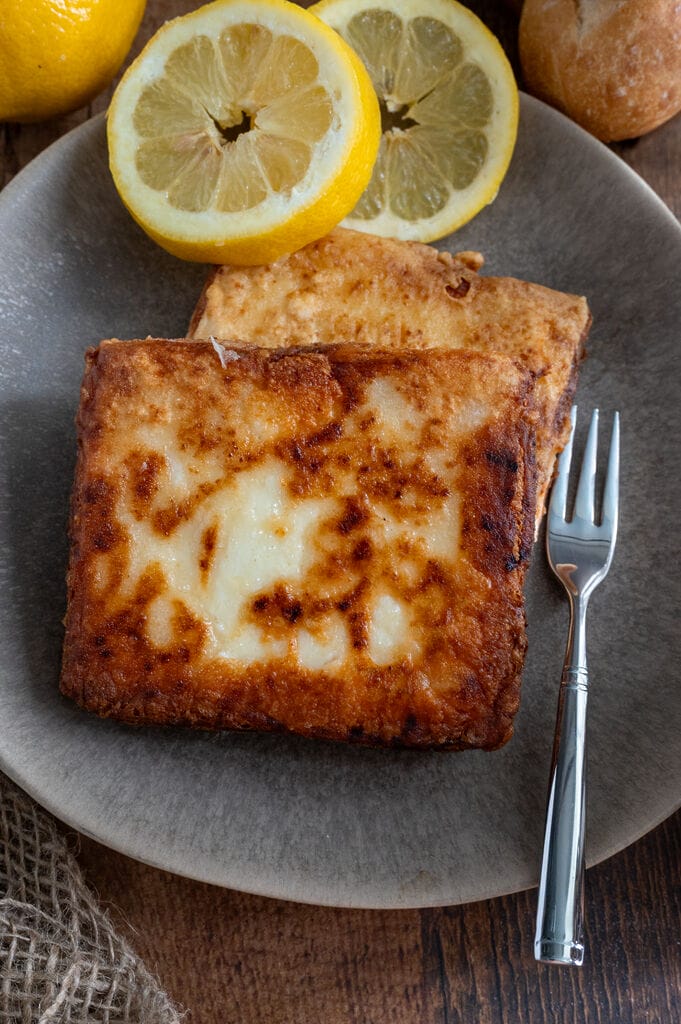
Related recipes
If you love Greek cheese saganaki, then I think you will also love these amazing meze recipes:
Kefalotyri cheese crisps Consider yourself warned! These Greek cheese crisps are easy to make, and easier to eat. They are absolutely delicious on their own, or served with a salad. Delicious!
Loukaniko with kefalotyri So simple, but honestly, so good! Greek sausage is stuffed with Greek kefalotyri cheese and then baked. Every bite is amazing.
Warm feta packages I love this appetizer. Make it ahead and then pop it onto the grill until the feta gets warm and soft.
Shrimp saganaki (Greek shrimp with tomato and feta) Probably the best shrimp saganaki recipe you will try, and that is not an exaggeration!
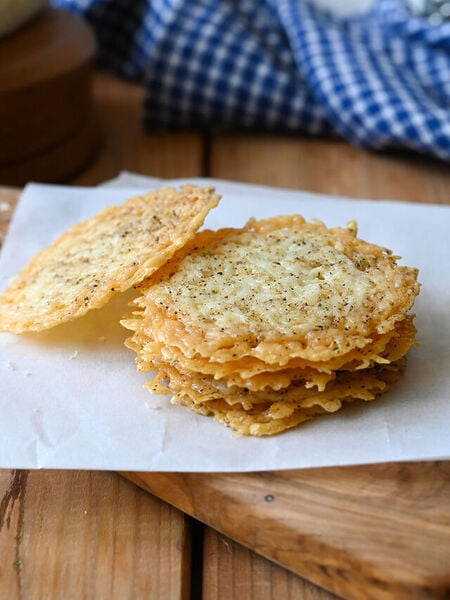

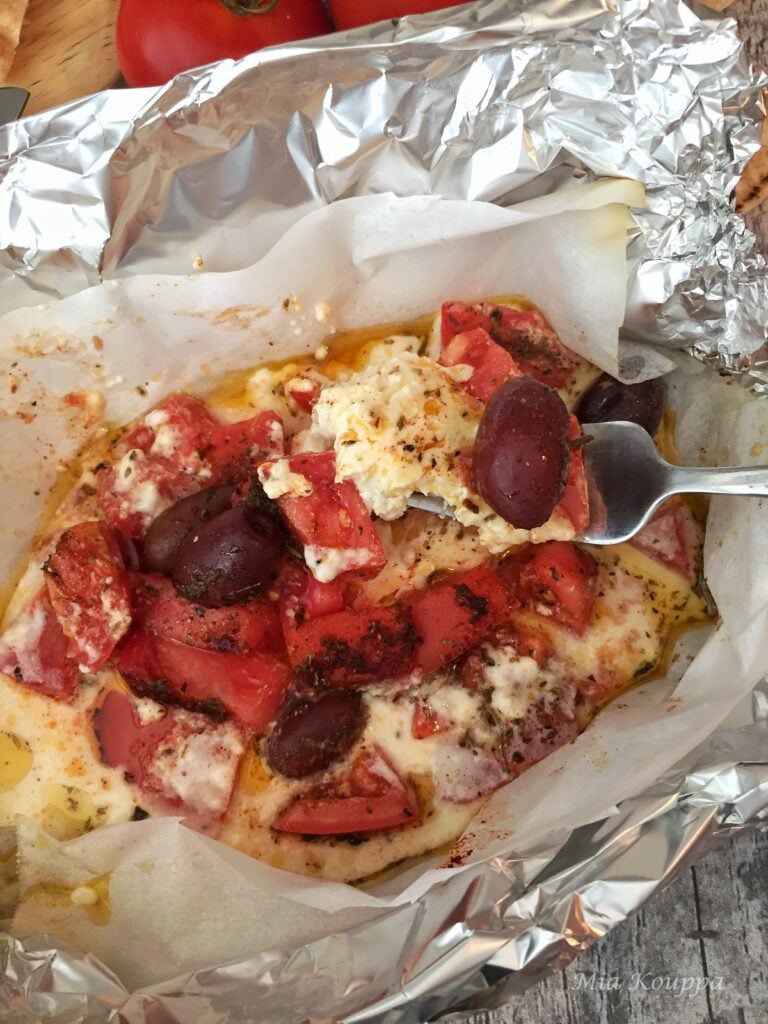

Subscribe to our newsletter
We love hearing from you! If you have made our recipes, or if you have a question or comment, or simply want to say Hi!, please leave a comment and star rating below! Also be sure to follow along with us, on Facebook, Instagram and Pinterest. We have lots of fun over there.
This post may contain some affiliate links, which means that we make a small commission off items you purchase at no additional cost to you.
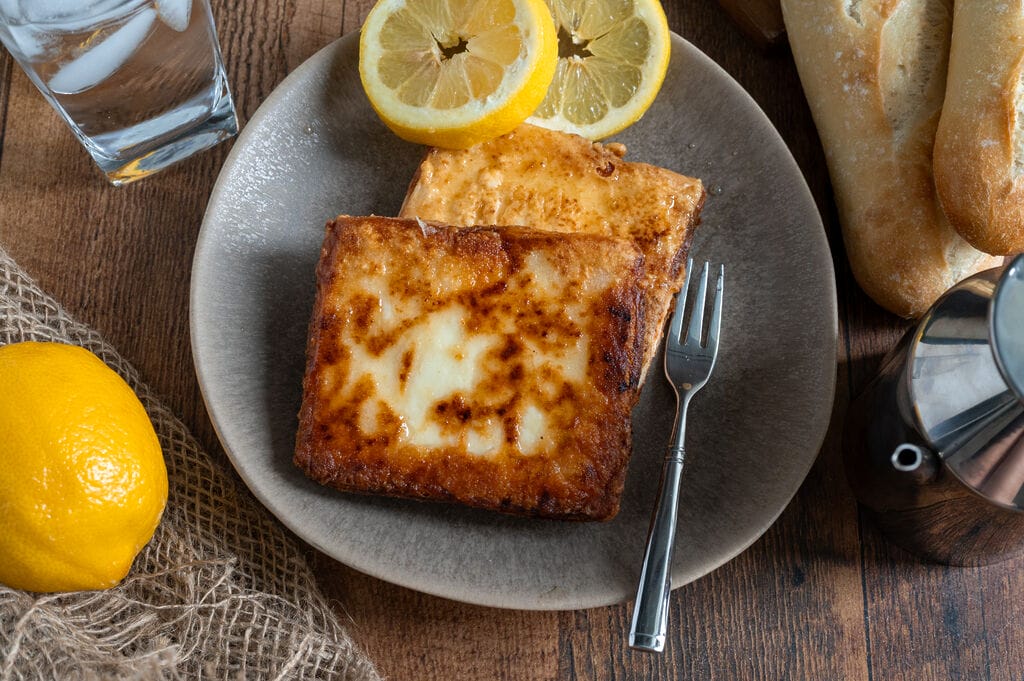
Please rate our recipe *****
Recipe for Greek Cheese Saganaki
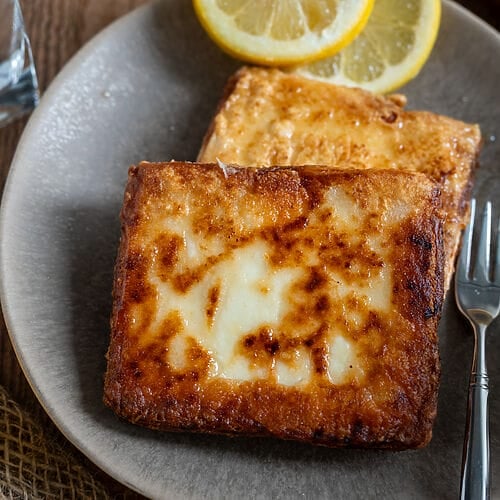
Greek Cheese saganaki
Equipment
Ingredients
- 4-6 pieces Kefalotiri or kefalograviera cut into 1/2 thick pieces, each about 4 inches long, and 2 inches wide (approx)
- 1 cup all purpose flour
- 1 teaspoon sugar
- 1 tbsp plain breadcrumbs
- olive oil for frying
- 2 tbsp Brandy (Metaxa) or Ouzo optional
- lemon wedges, to serve
Instructions
- Find two bowls whose dimensions are larger than the pieces of cheese. In one, mix together the flour, sugar and breadcrumbs. Fill the second bowl with ice water.1 cup all purpose flour, 1 teaspoon sugar, 1 tbsp plain breadcrumbs
- Pour enough olive oil into a frying pan so that it covers the bottom of your pan and is about 1 cm deep. Heat over medium heat.olive oil for frying
- Taking one piece of cheese at a time, dunk it into the ice water and then coat it with the flour mixture. Dunk back in water, then back in flour. Finally, dunk quickly in the water for the third and last time.4-6 pieces Kefalotiri or kefalograviera
- Immediately place your cheese into the preheated frying pan.
- Repeat with the other pieces of cheese, and fry as many as you can at the same time, without overcrowding the pan.
- Fry each side for about 3 – 4 minutes until golden brown. Flip over carefully and fry on the other side.
- Optional: If using the alcohol, remove the pan from the heat source and add the alcohol. Be sure to set the pan on a surface with plenty of space over it. Use a long handled lighter to set the alcohol aflame and step back. In a few moments the alcohol will burn off and the flame will die out. Please exercise caution with this step and read the Recipe Notes for further safety advice.2 tbsp Brandy (Metaxa) or Ouzo
- Serve immediately with lemon wedges.lemon wedges, to serve
- Enjoy!

I loved ordering this at Greek restaurants! They always light it on fire right at your table!
Yes! We love that! Sometimes we do that at home as well (or rather, our husbands do…flambé makes us a bit nervous 🙂 ) If you want to try doing this at home, simply add a bit of ouzo or Metaxa brandy to your pan, remove from the direct heat, and light it with a lighter or match. Enjoy! … and be careful 🙂
Could this be the best dish ever created by the Greeks? My all time favourite. Especially with a little honey and thyme.
Oh! That sounds amazing. Will definitely try it with honey and thyme next time! Thanks 🙂
Thank you for recipe. Made with Vegan Halloumi! From Cook & Let Live cookbook. Gentle chef dot com. Check it out
Amazing! Glad you loved it!
Step one confuses me. The period after water. Then a repeat of flour, sugar, crumbs???
Hi Gloria! Thanks for your question. You may notice that the repeat of flour, sugar and breadcrumbs after the period after the word water are in a lighter font. That is basically an explanation of the amount of each ingredient to use in each relevant step. In many recipes for example, it will say combine flour, sugar and breadcrumbs…and then you have to scroll back up to the list of ingredients to see exactly how much flour, sugar and breadcrumbs. Instead, we include these amounts right after the instructions. Hope that is clear. Let us know if you have any more questions 🙂 xoxo Helen & Billie